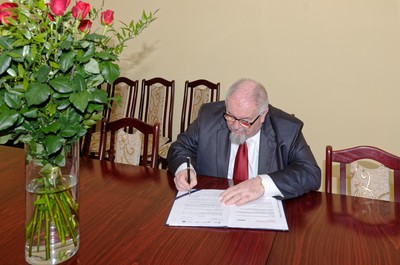Hunters of cosmic ray particles come together in CREDO
11 September 2019
EurekAlert!: [https://www.eurekalert.org/pub_releases/2019-09/thni-hoc091119.php]

Prof. Marek Jezabek, director of the Institute of Nuclear Physics of the Polish Academy of Sciences in Cracow, signs an agreement on formal accession of the Institute to the international CREDO project. (Source: IFJ PAN)
A planet wide particle detector known as CREDO has been established by research and education organisations, bringing together individual citizen scientists from nearly every continent. All smartphone owners can participate in this undertaking that attempts to test the quantum structure of spacetime to the potential relationships between cosmic radiation and earthquakes and even the role played by high energy cosmic rays in cancer.
The international Cosmic-Ray Extremely Distributed Observatory (CREDO) project began in 2016 at the Institute of Nuclear Physics of the Polish Academy of Sciences (IFJ PAN) in Cracow, and is now transformed into a formal worldwide structure. Under the agreements signed, 25 institutional entities from 12 countries on 5 continents are currently involved in the construction of the global planetary particle detector CREDO: nine from Poland, three from the United States, two from Australia, the Czech Republic and Ukraine, and one each from Georgia, Mexico, Nepal, Russia, Slovakia, Uruguay and Hungary. They include scientific institutions that are significant not only on a Polish scale (including the Jagiellonian University, Cracow University of Technology, Astronomical Observatory of the University of Warsaw, IFJ PAN), but even globally (Massachusetts Institute of Technology). At the same time there is no shortage of educational entities, from the Copernicus Science Centre in Warsaw to primary schools. CREDO is made possible by a growing number of amateur enthusiasts, using their smartphones to register cosmic radiation particles.
“Expanding the boundaries of human cognition has always been, is and always will be a difficult
process, with the increasing complexity and subtlety of the phenomena under investigation
requiring ever greater financial, time and human resources
”, says Prof. Marek Jezabek, director of
IFJ PAN. “That is why it is so important to skilfully use all the possibilities already present in
existing equipment and to involve as many people as possible in the implementation of scientific
projects – not only scientists but also enthusiasts. We are proud that the CREDO project, born in
our Institute, is trying to implement these ideas both nationally and globally
”.
Project coordinator, Dr. Piotr Homola, professor at the IFJ PAN, explains its essence: “What makes
the uniqueness of CREDO is the combination of data from very many different detectors recording
particles associated with cosmic rays. We are talking here about fully professional detectors, built
and managed by large centres or scientific consortia and often costing a lot of money, as well as
those that are cheap, less sophisticated, but much more common, like CMOS sensors in the
cameras of smartphones
”.
The CREDO project uses smartphones as detectors of cosmic radiation, known as cosmic rays. The camera in a smartphone detects a cosmic ray as a track across the CMOS when struck. As the camera are small, much less than a square centimetre in area, they are poorly suited for studying local phenomena like extensive air showers (i.e. cascades of secondary particles initiated by high-energy cosmic rays interacting with the Earth's atmosphere) reaching the surface of our planet. In the case of CREDO, the key is that smartphones are found in many places around the globe. Such large spread means that the collected data can track changes in time between the numbers of detected particles and learn about global changes in the cosmic ray numbers reaching the Earth.
One of the participants of the CREDO project aiming at detecting cosmic-ray ensembles is the Quantum Gravity Previewer experiment, searching for anomalies in the cosmic-ray arrival time distributions in single devices or local groups of detectors, mostly smartphones, in various places around the globe. The inspiration here is a scientific experiment from 1983, when in just five minutes, a network of cosmic ray detectors in Manitoba observed as many as 32 cases of extensive air showers (compared to just one that had been expected!). The study of such phenomena, currently incomprehensible to science, is one of the goals of CREDO and could explain, among others, whether the observed fluctuations result from the bizarre features of cosmic accelerators, or maybe from the effects of interactions of the products of particle decay with the quantum structure of spacetime.
Another research topic of the CREDO project is the impact of cosmic rays on human health. Although the average intensity of secondary cosmic radiation is not considered harmful (it is several times smaller than the intensity of the natural radioactivity of the environment), the impact on human health of extensive air showers, i.e. cascades of secondary particles initiated by cosmic rays with very high energies, has not yet been studied. The CREDO project will conduct this sort of pioneering research, going beyond the existing framework both in the fields of the physics of cosmic radiation itself and knowledge about the possible biological response of the human body to this radiation. These studies will be conducted taking into account global trends in understanding the impact of low doses of radiation on living organisms in terms of the possibility of the occurrence of both positive phenomena (e.g. increasing the immunity of organisms) and negative ones (e.g. diseases of unknown aetiology, including some types of cancer).
CREDO has the chance to verify another spectacular hypothesis, so far measured only once – concerning the relationships between earthquakes and changes in the cosmic ray flux reaching the surface of our planet. It is assumed that stresses in the Earth's crust can generate anomalous electromagnetic fields above the surface, which would affect the number of cosmic ray particles registered. If the phenomenon were confirmed, quantitatively examined and understood, we might even be tempted to design warning systems against impending earthquakes.
To connect your smartphone to the CREDO detector cloud, simply install the CREDO Detector app from your smartphone’s store, and run it with the camera lens covered (see https://credo.science/ for details). The maintenance and development of this app is supervised by the Cracow University of Technology, and the Academic Computer Centre CYFRONET of the AGH University of Science and Technology in Cracow supervises the collection and processing of data from around the world (not only from smartphones).
CREDO is a doubly open observatory. Anyone can join with their data, anyone can also access all the scientific data (with, of course, full respect for the privacy of users). This also applies to the implementation of scientific ventures which have not yet been included in the formal research programme of the project.
The initiators of CREDO strive to appreciate all the entities involved in the project, including people from outside the formal world of science. Co-founders of CREDO have the right to co-authorship of scientific publications based on the collected data. In turn, you can keep track of the graphs created in current experiments on the project website. All users can check the input of their data here, and can also become involved in all the analyses.
“We believe that scientific projects should enable not only data collection, education or individual
development, but should also give perhaps not fully scientific but still very satisfying cognitive
pleasure
”, emphasizes Prof. Homola. “In this spirit, we've thought up the continuous Particle
Hunters contest, aimed mainly at pupils and students, enabling individual and team competition
between smartphone owners. Currently, over 1,200 pupils from around 60 schools are participating
in the competition. For now, these are Polish schools, but we hope that over time, the competition
will expand to other countries
”.
Smartphones are just one type of detector recording cosmic ray particles within CREDO. Soon, networks of small and inexpensive detectors like Cosmic Watch will be able to transmit their data. Networks of this type can be constructed even by not very advanced electronic amateurs, modelling, for example, on an open project originally developed by MIT for the famous IceCube neutrino detector.
The openness of CREDO enables the practical and immediate inclusion of professionals in the project, allowing them to analyse data that for others are just an unnecessary or even unwanted background. These include muons of cosmic origin, recorded by professional ultra-high energy cosmic ray observatories, neutrino and dark matter detectors, astronomical observatories equipped with telescopes with CMOS sensors, as well as accelerator centres with their specialist elementary particle detectors.
“The real strength of CREDO lies in its physical multiculturalism. We try to combine data on
different types of radiation, with different energies, recorded by different methods. We hope that in
this way we will open a new window to the Universe and better understand the fundamental
features of our reality
”, sums up Prof. Homola.
More information on cosmic radiation and the CREDO project can be found in the press package associated with this press release. The package is available in the IFJ PAN press service at: https://press.ifj.edu.pl/.
[PDF]
Contact:
Dr. Piotr Homola, professor at the IFJ PAN
The Institute of Nuclear Physics, Polish Academy of Sciences
tel. +48 12 662 8341
email: piotr.homola@ifj.edu.pl

